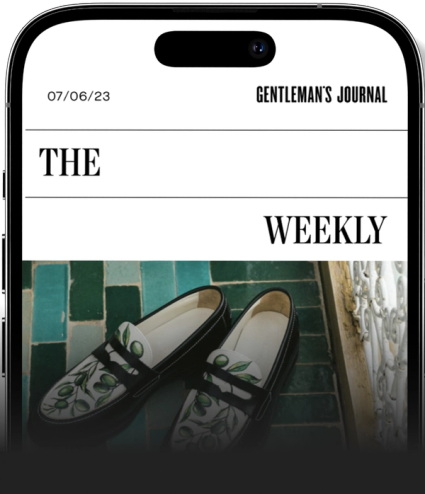
“You can be a nice guy but also a ruthless athlete”: George Russell lifts the visor
“I feel ready to be world champion,” says George Russell, IWC ambassador, Mercedes driver, and mental health campaigner. “You’ve just got to keep persevering. And sometimes, when you least expect it, that’s when it happens…”
Words: Joseph Bullmore
Grooming: Paul Donovan using Bumble and bumble
Styling: Ben Browne
No photoshoot in the history of mankind has ever finished on time. But George Russell’s wrapped up precisely 37 seconds earlier than it needed to. We had two hours with the Mercedes driver in which to do the following: dress him in three rather lovely outfits, get a series of portraits on the streets of Mayfair, shoot a behind-the-scenes video, conduct an in-person interview, travel to Cafe Royal on Piccadilly to host a dinner with IWC Schaffhausen, and conduct a lively panel discussion for 60 devoted Formula One fans. Is there a land speed record for cover shoots? To watch George and his team at work — a multi-part, smoothly-cogged machine of slick synchronicity — is to reach constantly for metaphors: they are like a jaw-droppingly efficient pit crew, perhaps; or the silent, infinitesimally-precise inner-workings of some fine, lovely automatic watch. I’m told that if a falcon watched television, it would assume it was sitting in front of an achingly slow slideshow, such is the processing speed of the bird’s eyes and mind. Before you even get to the on-track heroics — the sheer physical and mental ridiculousness of driving the fastest cars in the world competitively for a living — you sense that George is a falcon on the sofa; eyes profound and heartbeat slow.
It is appropriate that we have been brought together by a watch partner, I say, as we sit across from each other in a quiet room above the IWC flagship on Bond Street. IWC and Mercedes have enjoyed one of the longest heritage partnerships in Formula One, and George says he has been an ardent fan of the ancient, modern marque even before he joined the team in 2022. I comment on how disciplined and millimetric and precise the afternoon has been. Does he think a lot about time? “I’m now recognising how important my own time is, not only on a professional level — racing in an F1 car, where it’s all about the time — but also appreciating how much I value my own time,” he says. “So everything has been planned to the millisecond, which is how I like it.”

George wears the IWC Portugieser Chronograph iwc.com, Thom Sweeney thomsweeney.com with Edward Green shoes edwardgreen.com.
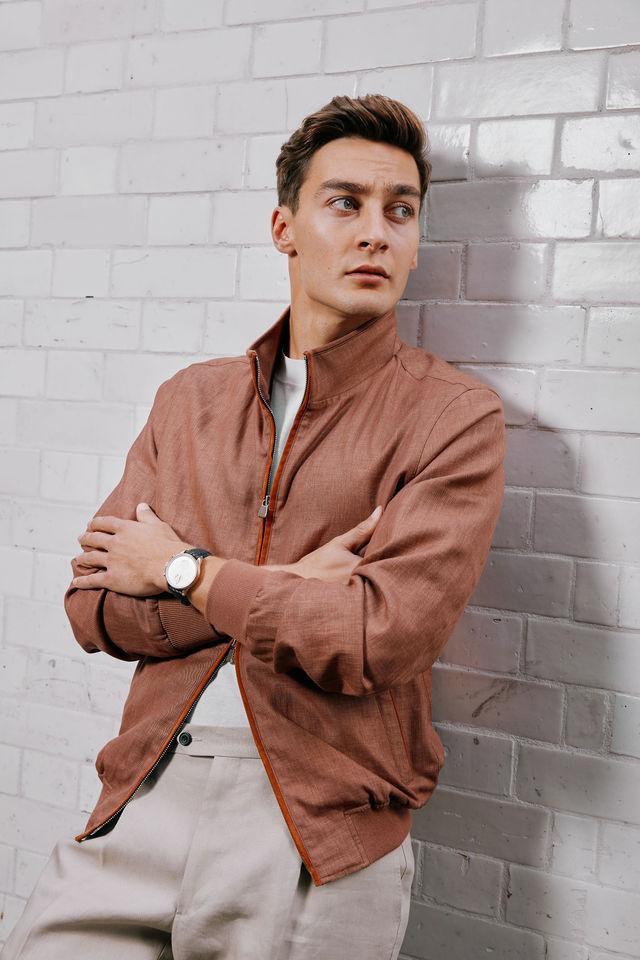
George wears the IWC Portugieser Chronograph iwc.com, Thom Sweeney thomsweeney.com with Edward Green shoes edwardgreen.com.
It has certainly taken a long time to move this fast. George — 25 years, 4 months, and 22 days old at the time of writing — left school at the age of 14 to pursue his career behind the wheel. All drivers start incredibly young (George was winning karting competitions at seven.) But this must have felt like a bold move in an industry that is precarious at best, brutally competitive throughout, and characterised by sliding-doors moments, quirks of fate, milliseconds that are worth entire careers. Did it feel bold and risky at the time?
“Now I look back at the responsibility it took for [my parents] to make such a bold decision, it couldn’t have been easy,” he says. “I think there are things in school I have missed out on, but there’s also a hell of a lot I’ve learned in life that school couldn’t have taught me. From the ages of 14 to 18, when I was travelling the world racing, I was working with engineers who were thirty or forty years older, and going to dinner with my mechanics who were in their late twenties. That matures you a lot to the world. I feel like I grew up a lot quicker,” he says.
“It also meant I stayed out of trouble. I had people who I grew up at school with who got into a lot of mischief, as a lot of teenagers do, going out partying and drinking. I missed out on that side of social life. Whether that’s a positive or a negative, who knows. But I wouldn’t have changed it for the world.” Either way, at this precise moment, the gamble looks to have paid off. All careers look smoother in hindsight, and George is refreshingly open about the mistakes, stumbling blocks and setbacks that have punctuated the last decade. But the general trend — the Wikipedia trajectory — has been upwards, upwards, upwards: a whistle-stop climb through karting, Renault Formula 2.0, Formula 4, Formula 3, Formula, GP3, Formula 2, and then, finally, the big one.
Again, timing is everything. In 2014, having won the Formula 4 title, a 16-year-old George sent an email to Mercedes team boss Toto Wolff, humbly asking for a meeting and potential future shot at one of those 20 coveted seats. “I didn’t plan it this way, but I sent that email two days after the championship had finished,” says George. “Timing’s exceptionally important. There was a lot of success and happiness [at that moment]; a relaxed environment. Perhaps if I had sent that email three days earlier, it would have just got caught up in that craziness of the race weekend. And perhaps I wouldn’t be sitting here today.”
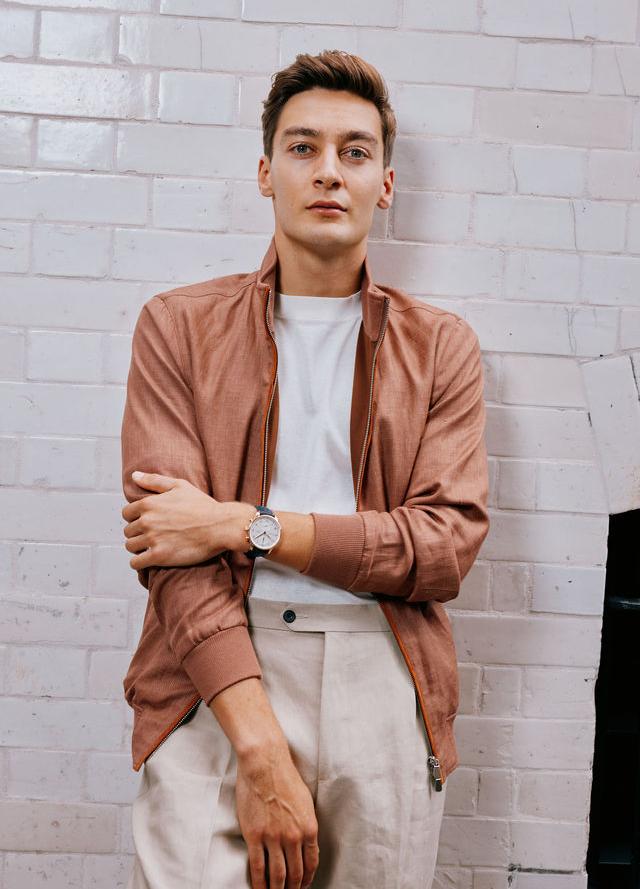
George wears the IWC Portugieser Chronograph iwc.com, Thom Sweeney thomsweeney.com with Edward Green shoes edwardgreen.com.
Does he think those soft skills — the ways of communicating, his clear thoughtfulness, being polite and kind — are useful, in some unsung way, to a driver’s success on the track? “First impressions are very important,” he says. “Maybe if [his first message to Toto] had come across in an arrogant way, I wouldn’t have gotten a reply to that email.” He says the main things he has learned from Wolff and from Lewis Hamilton, his race partner at Mercedes, are all around “being a grounded and humble person,” he says. “It doesn’t matter if you’re the greatest of all time, or you’ve never had any success — you need to be a grounded person, be humble, treat everyone with respect. They’re things that will take you far in life.”
But still, he tells me, “there’s a clear distinction between being a nice guy, a polite guy — but also being a ruthless athlete. It’s about having that respect, charisma and humbleness in certain scenarios — but also about having that that fire when the helmet is on. That’s a very important distinction.”
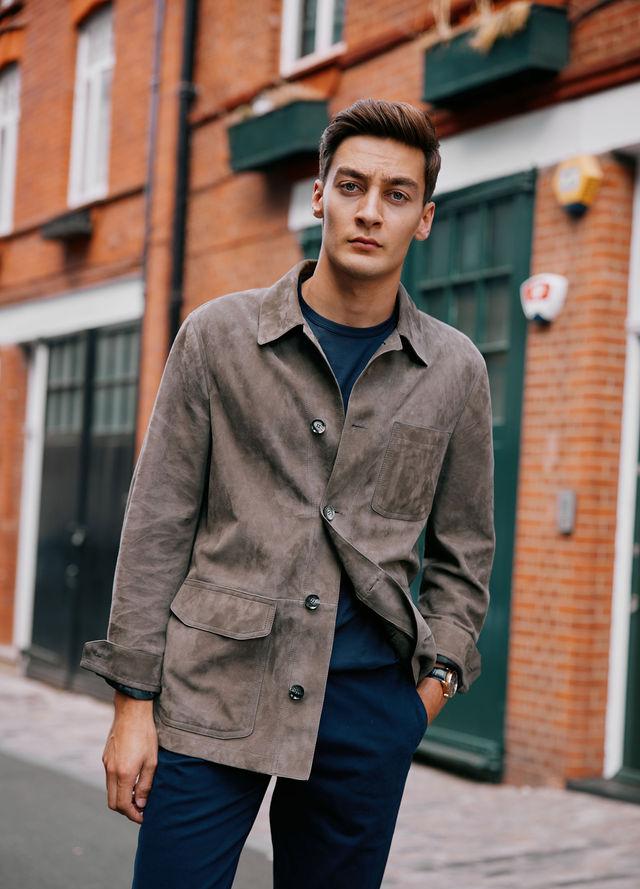
George wears the IWC Portugieser Chronograph iwc.com, Brioni Jacket brioni.com, T-shirt by Sunspel sunspel.com, Trousers by Orlebar Brown orlebarbrown.com and shoes by Tods tods.com
That fire fueled a successful debut year in a Mercedes car for George. In April 2022, at the Australian Grand Prix, he achieved his first Mercedes podium. In July, in Hungary, he earned his first pole position. And then, in November, at Sao Paulo, George claimed his first Grand Prix victory, holding off Max Verstappen and Kevin Magnussen in an impressive performance. This year, he says, the team has had “some bad luck”, though he has been pleased with his own performance in general. We meet on the Wednesday before the British Grand Prix — always a slightly more pressurised and poignant race for homegrown talent — and there is a sense of calm confidence about the task ahead. When things can be improved, George says, it is important to work smarter, not simply harder. “I could be on the simulator five days a week, putting in even more hours on my driving,” he says. “But it wouldn’t make me faster. Having those days when I can step back and think about things with a more open vision is important. We can be so fixated in our job. Sometimes you miss the obvious.”
Are there two Georges, I ask? An on-track George and an off-track George? “When the helmet is on, you turn into this animal with one goal; extremely driven,” he says. “You have tunnel vision. You’re looking through this visor — it’s as tunnel vision as you can get. Nothing else matters.” But it is sometimes tricky, he says, when that on-track intensity is broadcast, often out of context, to an off-track setting. “It’s a bit challenging, because all the radio messages [from the cockpit to the race team] are broadcasted now,” he says. “The things you say under the highest pressures are scrutinised and broadcast to the world. And that’s a challenging place to be when you’re representing a brand like Mercedes, or IWC, or any of the other amazing brands and partners we have on our race car, and the 2000 people who work for the company. You’re representing more than just yourself — you’re representing thousands and thousands of people, and you want to make them proud on track with your performances. But it’s important not to let people down with actions you do in the heat of the moment, but may regret an hour later.”

George wears the IWC Portugieser Chronograph iwc.com, Brioni Jacket brioni.com, T-shirt by Sunspel sunspel.com, Trousers by Orlebar Brown orlebarbrown.com and shoes by Tods tods.com
The job of an F1 driver has always been unthinkably intense. But it feels much harder for drivers now — in the age of 360 observation, 24-hour coverage, and armchair Twitter critics — than perhaps it was even just 20 years ago, say. The helmet is a goldfish bowl as much as a shield. “Well,” George says, with Falcon-like perspective, “I think it’s a much more intense environment for every single individual on earth now. We’re all scrutinised. Everything we say on social media is being judged. Every photograph a teenager is posting on social media is being judged, idolised, criticised. It’s a brutal world, and I think the larger the profile, the harder that is. It sometimes feels like nobody can do right. You open your mouth and you will upset somebody.”
That’s why, he says, the emergence of Netflix’s gargantuan hit Drive to Survive has been so refreshing. While it has brought some added pressure in that it’s awoken a new, much wider audience for the sport, it has also allowed the season some necessary breathing room; the context and zoomed-out perspective that the live, magnifying-glass coverage of each weekend often misses.
“It’s broadcast a year later, so there isn’t that initial reaction to a crash, or a comment, or something that’s been said ten minutes after a race has finished,” George says. “Whereas when you’re dealing with the on-site, live media, people have views, reactions, emotions straight away. And that’s why you’re also reserved to speak from the heart, because someone’s going to take offence from it, and it’s going to spiral, and it’s going to cause you pain from reading.” Does he read the Twitter comments? “No.”
That scrutiny, that pressure — and the clear empathy George has for other people of his generation, the first to mature almost entirely under the blazing, distorted gaze of social media — is one of the reasons he began working with Meta on a mental health campaign last year. As the editor of a magazine largely for young-ish men, I can attest that the ‘conversation around male mental health’, as it is so often loftily dubbed, can be waffly and buzzword-y and earnest beyond usefulness — sincere without being serious; optics over actual advice. So I ask George for one clear thing he would say to young people of his age.

George wears the IWC Portugieser Chronograph iwc.com, Brioni Jacket brioni.com, T-shirt by Sunspel sunspel.com, Trousers by Orlebar Brown orlebarbrown.com and shoes by Tods tods.com
“Don’t be afraid to fail,” he says without pausing. “There’s a huge amount of scrutiny upon people to not make mistakes; to try and be a perfect individual. But it’s definitely okay to make mistakes, and to learn from them, and I can just speak from my own experience: my mistakes were the toughest times of my career, but they’re what has defined me as a person — not just as a professional driver, but as an individual. As much as I regret all those mistakes, and wish they didn’t happen, I sit here now and know they’re the things that have defined me.”
Earlier, I had asked George whether, if he could click his fingers now and be crowned instant world-champion, he’d take the accolade; or whether he would want to earn it, graft for it. “You don’t want an easy journey,” he says. “Those who have an easy journey with no failures will always get slipped up in the future at some point. Yes, I feel ready to be world champion. I feel like I’m performing at the highest level I’ve performed. I’m going head-to-head with the greatest driver of all time, and last year was a great season for me. On a personal level I feel like I’m doing a good job. I have faith that everybody gets their opportunity,” he says.
“And yes, I wanted to be world champion yesterday. But unfortunately life doesn’t happen that way. You’ve got to keep persevering. And sometimes when you least expect it, that’s when it happens.” George Russell is moving fast. But he is not in a hurry.
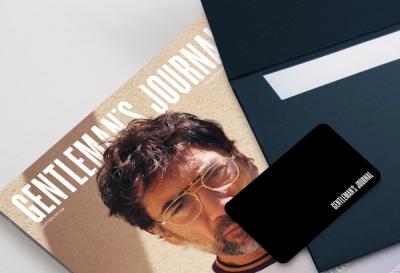
Become a Gentleman’s Journal Member?
Like the Gentleman’s Journal? Why not join the Clubhouse, a special kind of private club where members receive offers and experiences from hand-picked, premium brands. You will also receive invites to exclusive events, the quarterly print magazine delivered directly to your door and your own membership card.



